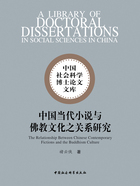
Abstract
From the perspective of the relationship between literature and Buddhism culture to do some research about contemporary Chinese fictions has not yet been fully developed in the field of Chinese literature study so far.Although a few researchers have realized that it could be a new perspective to help us know more about the details and aesthetic value of contemporary Chinese literature,they just focused on the testimony of the relationship between literature and religion,one writer or someone's specific works instead of macroscopic handling and deep analysis.Actually,as one origin of Chinese writers’ thinking resources,the Buddhism culture not only plays a key role in the aspect of literary aesthetics after modern transformation,but also becomes a crucial access to find the new qualities of Chinese narrative works.Especially in the 21th century,under circumstance of the Western literature theories,which once dominated the filed of contemporary Chinese literature study,can't continue to provide new and effective critical methods any more,trying to trace back to an old origin that enlightened Chinese literature may help us finding an effective approach that works for contemporary Chinese literature research.
Most of researchers considered that the Buddhism culture,which deeply affected generation and development of Chinese fictions totally disappeared in contemporary Chinese literature,as well as Chinese contemporary writers were regarded as the generation without religions feelings.In my point of view,the relationship between them really becomes more invisible in comparison with in ancient and modern times,but this kind of interaction effect never disappeared in anytime,it goes deep into the texture of fictions such as the discourse,narrative structure,time line,space,characters creation and language of Chinese contemporary fictions in an unconsciousness way.Even though in the time of revolutionary literature when ideology was strictly controlled by the nation,Buddhism culture still scattered with Buddhism figure of speech in the red narrative in first twenty-seven years after the new China was established.Meanwhile,Chinese contemporary fictions always keep reconstituting and creating this traditional Buddhism resource,making it seems that the relationship between Buddhism and contemporary fictions is different from classical and modern fictions.This dissertation focus on the functional layer,structural layer,symbolic layer of Chinese contemporary fictional texts in terms of timer shaft and spatial arbor,research the construction for aesthetic pattern of Chinese contemporary fictions and possibility of making a dialogue with the world literature in the frame of the relationship between Chinese contemporary fictions and Buddhism culture.
First of all,this is an issue on narrative of Chinese contemporary fictions. From the aspect of discourse of fictions,the prototype of Buddhism stories revived again through fiction-texts,forming the new morphology of stories as well as the metonymies for the times of profaneness and Reenchantment for mystery tradition of Chinese fictions narrative.The three core ideas of Buddhism culture-causes and effects of three lives,dependent-arising and emptiness,the equality of all living creature also have a great impact on the spiritual connotation of Chinese contemporary fictions,more and more Buddhism texts take on functions of mirror-image and prophecy expression.From the pedigree of characters in Chinese contemporary fictions,Buddhism culture constantly enriches and changes the monks/nuns images that have constructed in ancient times,drawing the outline of situation about Buddhism nature in this secular world after 1949.There is no denying that the influence of Buddhism culture on the time and space in Chinese contemporary fictions is a very important issue that should not be neglected.Metempsychosis as a sense of time has not only broken the linear time that is predominant since the period of revolutionary literature,offering a kind of time mode of Cyclicity that benefits from traditional resources but contains new elements.Meanwhile,it provides a possibility for reconstructing the narrative integrality of Chinese contemporary novels in a time when the metastatement that dominated the whole world has been fragmented.In addition,because the different cognition on space in comparison with Atheism,the senses of Trailokya and Six Paths in Buddhism culture make a contribution for extending narrative spaces in Chinese contemporary fictions,some special regional spaces such as Tibet area,monasteries take on the salvation function for human nature and spirit in spatial narratives.From the aspect of Buddhism aesthetics,Buddhism images still possess original symbolic meanings in the fictions texts,and they combine with fictions narrative skills from western world,some new geographical images like Tibet appear in Chinese contemporary literature as well.Zen,one of the schools of Buddhism has the sense of unity of opposites about language and pursuit for realm of emptiness and peace,that enlighten the discourse structure and artistic conception of Chinese contemporary fictions,forming a kind of expressing way containing Chinese traditional taste and advant-garde spirit.Second of all,Chinese contemporary Buddhism fictions as a special writing type have been returned to the system of Chinese narrative literature after the new century,no matter as one kind of texts or a cultural phenomenon,it really implicates that Chinese people are suffering a crisis about spiritual belief.Just because of this,the research from the perspective of the relationship between Chinese contemporary fictions and Buddhism culture is not only a discussion about literal narrative,but also refer to some anthropological proposition such as life and death,the sacred and the profane,and the ultimate concern of literature.
Key words:Chinesecontemporary fiction;Buddhism culture;the ultimate concern of literature;localization;cosmopolitan